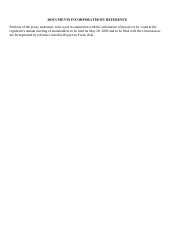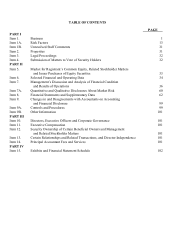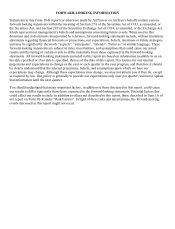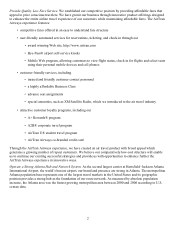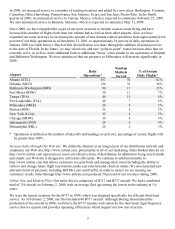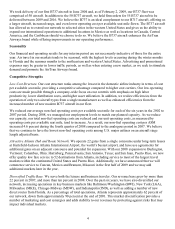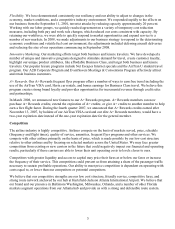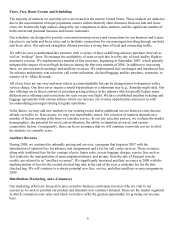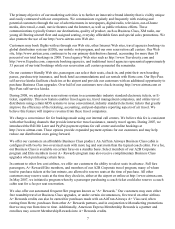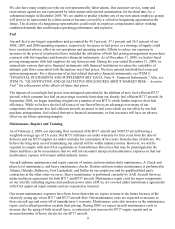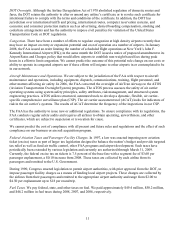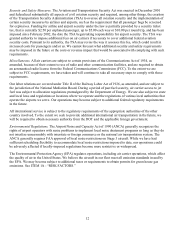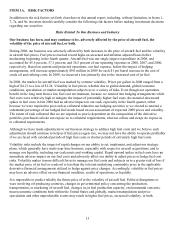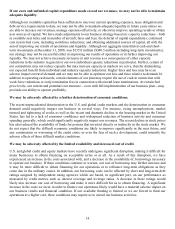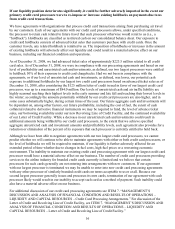Airtran 2008 Annual Report Download - page 14
Download and view the complete annual report
Please find page 14 of the 2008 Airtran annual report below. You can navigate through the pages in the report by either clicking on the pages listed below, or by using the keyword search tool below to find specific information within the annual report.Fares, Fees, Route System and Scheduling
The majority of markets we currently serve are located in the eastern United States. These markets are attractive
due to the concentration of major population centers within relatively short distances from our hub and focus
cities, the historically high airfares charged by our competitors in these markets, and the significant number of
both current and potential business and leisure customers.
Our schedules are designed to provide convenient nonstop service and connections for our business and leisure
travelers to our hubs and focus cities and to facilitate connections for our passengers traveling through our hubs
and focus cities. Our network strength in Atlanta provides a strong base of local and connecting traffic.
We offer an easy to understand fare structure with a variety of fares at differing advance purchase intervals as
well as “walk-up” fares. We manage the availability of seats at each fare level by day of week and by flight to
maximize revenue. We implemented a number of fare increases, beginning in September 2007, which partially
mitigated the impact of record high fuel prices during the first nine months of 2008. In addition to increasing
fares, we also increased surcharge and ancillary revenues. We implemented fuel surcharges and introduced fees
for advance and priority seat selection, call center utilization, checked baggage and the purchase, extension, or
transfer of A+ Miles Rewards.
All of our fares are one-way and most tickets are nonrefundable but can be changed prior to departure with a
service charge. Our fares never require a round trip purchase or a minimum stay (e.g., Saturday night stay). Our
fare offerings are in direct contrast to prevalent pricing policies in the industry which typically feature many
different price offerings and restrictions for seats on any one flight. We have established interline ticketing and
baggage agreements with various airlines which can increase our revenue opportunities and assist us with
accommodating passengers during irregular operations.
In the future, we may add new markets to our existing routes and/or additional service between cities that are
already served by us. If necessary, we may exit unprofitable routes. Our selection of markets depends on a
number of factors existing at the time we consider service. In our city selection process, we evaluate the market
demographics, the potential for service diversification, the ability to stimulate air travel, and various
competitive factors. Consequently, there can be no assurance that we will continue to provide service to all of
the markets we currently serve.
Ancillary Revenue
During 2008, we continued to unbundle pricing and services, a program that began in 2007 with the
introduction of optional fees for advance seat assignments and a fee for call center services. These revenues,
along with traditional fees for the carriage of pets, liquor sales, excess baggage charges, service fees such as
fees related to the transportation of unaccompanied minors, and income from the sale of frequent traveler
credits, are referred to as “ancillary revenues”. We significantly increased ancillary revenues in 2008 with the
implementation of fees for the second checked bag and, at the end of the year, a moderate fee for the first
checked bag. We will continue to evaluate potential new fees, service, and other ancillary revenue programs in
2009.
Distribution, Marketing, and e-Commerce
Our marketing efforts are focused on price-sensitive business and leisure travelers who are vital to our
success as we seek to position our product and stimulate new customer demand. These are the market segments
in which consumers seek value and which we believe offer the greatest opportunity for growing our revenue
base.
6



